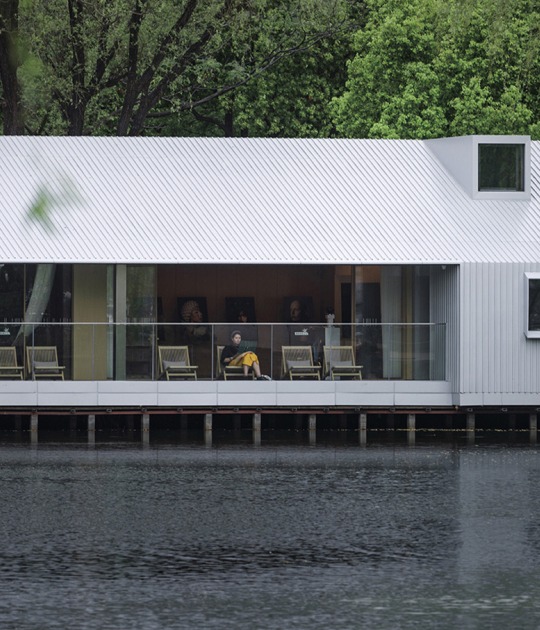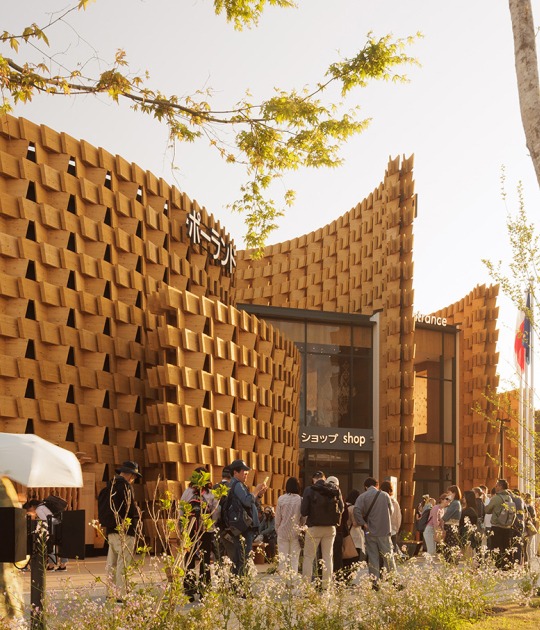Wet Dreams exhibition is structured around seven sections and brings together the works of around thirty international creators and collectives: design devices and practices, models, architectural drawings and projects, audiovisuals, photography, archival materials, ceramic pieces and installations, among others.
The exhibition "Wet Dreams" curated by Marina Otero Verzier, can be visited at CentroCentro Madrid, was inaugurated on March 9, as a result of the collaboration with "MAYRIT 2024", prelude to the third Madrid Design and Architecture Biennial. which will be held in May.
The show addresses the issue of water beyond its understanding as a resource and explores its role as a catalyst for eco-social relations by highlighting design practices that adopt decolonial, queer and hydro-feminist Anglo-Saxon approaches, emphasizing forms of embodiment, solidarity and desire, for the bodies of water and fluid materials.
The show addresses the issue of water beyond its understanding as a resource and explores its role as a catalyst for eco-social relations by highlighting design practices that adopt decolonial, queer and hydro-feminist Anglo-Saxon approaches, emphasizing forms of embodiment, solidarity and desire, for the bodies of water and fluid materials.
- In the Emanations and Soaking section, brings together projects on ritual architectures built around medicinal and healing waters, which emphasize the relationships between the health of human bodies and that of the planet. In this sense, it shows research such as that carried out by Ariadna Silva Fernández in the south of Galicia through photography; or the works based on archival material by Patricia Coelho and Marina Otero in Portuguese lands and by the latter on the San Isidro fountain in Madrid, as well as a puppet representation by Lluís Alexandre Casanovas Blanco that questions how water and its supposed Therapeutic virtues have been exploited to encourage tourism and large urban developments.
- Under the heading Rains and other discharges, it addresses the design of formulas to invoke rain and fertility of the territory, either through rituals such as the Rogativas pro pluvia, or through government actions, as reflected in the life-size model and the audiovisual by Marco Ferrari. and Elise Misao Hunchuck on the Chinese Sky River project, a plan to develop the largest cloud seeding project on the planet.
- Overflows of the repressed shows the installation Quedó en agua de borajs, by Elsa Casanova Sampé and Ana Robles Pérez, which focuses on the environmental catastrophe of the Riaño reservoir, which submerged nine towns, erasing their lands and stories in 1987; The Great Manmade River, by Mariam Elnozahy, examines, using archival material, the dreams associated with the Great Manmade River (GMMR), for some the largest irrigation project in the world, which promised water independence, agricultural abundance and the liberation of the foreign control for Libyans and Africans. It also includes the unpublished audiovisual piece All the Storms Have a Saint's Name, by Elena López Riera, a look at the floods of the Segura River that interweaves generations, climatic events and forms of dissidence against patriarchy.
- Shared Orifices and Fluids explores the use of bodily secretions as design materials. Here you can see pieces such as Tear Gun, designed by Yi-Fei Chen, a device that freezes and shoots the tears collected while we cry, the result of the author's struggle to freely express her emotions and ideas. Images of Symbiopunk, by Rebecca Schedler, a bioreactor and composting system that, through fungal cultivation, digests human faeces and transforms it into fertile humus. The film Grounded Bodies, Flying Plasma by Iván L. Munuera, investigates the history of blood trade and transfusion. And glass pieces that are part of the Co-Healing project, by Serina Tarkhanian, which proposes a collectivized care practice placing the microbial body and individuals as co-producers of sensory medicine.
- Pressure Valves and Overflowing Pipes analyze how these elements, generally hidden, are a fundamental part of the architectures of the liquid, aqueous and climatic. Includes projects by prominent international architects. Among others, meteorological architecture designs by Philippe Rahm; models and technical drawings of works by Andrés Jaque and Office for Political Innovation, such as the celebrated COSMO, a mobile device, built with customized irrigation components, that makes visible and enjoyable the hidden urbanism of the pipes that serve us every day. As well as technical drawings from different investigations by Pol Esteve Castello that analyze the architecture of dark rooms in Barcelona (together with Marc Navarro), and what was the largest sex club in Europe, Le Dépôt in Paris, or the golden decade of the saunas flourished in New York before the arrival of AIDS. In this section, the visitor can also see the image and sound installation Your Restroom is a Battleground, a project by Matilde Cassani, Ignacio G. Galán, Iván L. Munuera and Joel Sanders, which addresses bathrooms as political architectures, where gender, religion, race, ability, hygiene, health, environmental concerns, and economics are culturally defined and materially articulated.
- Hedonistic leaks and waste bring together design practices around the residual, toxic and smelly, such as the audiovisual Ca.Ca. (Cannibal Carnival) by María Jerez & elii [architecture office], which shows the network of organisms, technologies and landscapes that process and digest the city's waste; the model Tanks and Storms, from the Institute for Postnatural Studies, which reflects the network of tunnels, collectors and deposits that prevent toxins from the environment from reaching the Manzanares River. And the Deep Spa project of The Fourth Skin, images of a spa made of marble waste sludge from the extractive industry of Medio Vinalopó.
- Sensory Prostheses exposes a set of devices that connect bodies with multi-scalar climatic processes. Neo Coolers, by Claudia Paredes, are clay ceramics that cool spaces, particularly data centres, making use of the tradition of Spanish botijos and cooling structures inspired by termite mounds. Prosthetic Sensorium by Jan Christian Schulz, is a technological device that allows you to tune in and participate in meteorological phenomena such as storms or drizzle, even on the other side of the planet, through a prosthetic extension of the body. Finally, the section includes the documentary Listening to Ice, in which Susan Schuppli narrates how on the expedition to the Drang Drung glacier in the Himalayas sonic instruments allowed the study and embodied experience of the dynamics of melting.
The public program of the exhibition will propose different appointments with free entry until capacity is reached, the first took place on March 16, "Rains, discharges and overflows of the repressed." A session with chants, and presentation of rain rituals, cloud seeding projects and acts of disobedience against modern hydraulic infrastructures.
MAYRIT is a platform that highlights young and experimental creation at a global level in contemporary design and architecture. Directed by Miguel Leiro, it has been taking place in Madrid since 2020, focusing on water-related issues to underline the need to preserve cultural and natural resources.
More information
Published on:
March 17, 2024
Cite:
"Exploring the water. Wet Dreams by Marina Otero Verzier" METALOCUS.
Accessed
<https://www.metalocus.es/en/news/exploring-water-wet-dreams-marina-otero-verzier>
ISSN 1139-6415
Loading content ...
Loading content ...
Loading content ...
Loading content ...
Loading content ...
Loading content ...
Loading content ...
Loading content ...
Loading content ...
Loading content ...
Loading content ...
Loading content ...
Loading content ...
Loading content ...
Loading content ...
Loading content ...
Loading content ...
Loading content ...
Loading content ...
Loading content ...
Loading content ...
Loading content ...
Loading content ...
Loading content ...
Loading content ...
Loading content ...
Loading content ...
Loading content ...
Loading content ...
Loading content ...
Loading content ...
Loading content ...
Loading content ...
Loading content ...
Loading content ...
Loading content ...
Loading content ...
Loading content ...
Loading content ...
Loading content ...
Loading content ...
Loading content ...
Loading content ...
Loading content ...
Loading content ...
Loading content ...
Loading content ...
Loading content ...
Loading content ...
Loading content ...
Loading content ...
Loading content ...
Loading content ...
Loading content ...














































